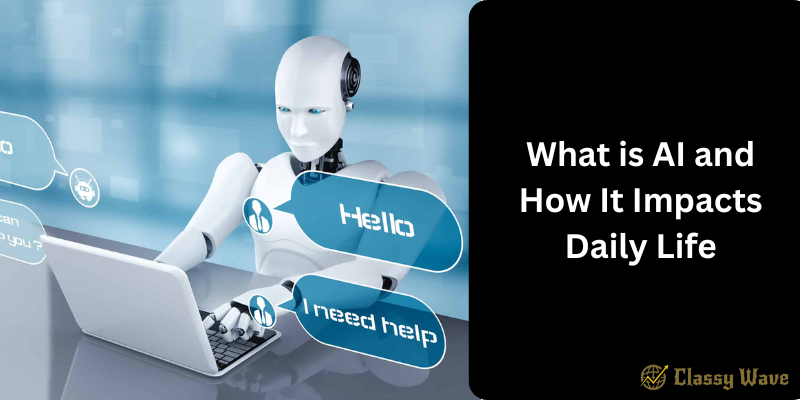What is AI and How It Impacts Daily Life | Classy Wave
Artificial Intelligence (AI) is no longer a futuristic concept — it’s already shaping the world we live in. From voice assistants like Siri and Alexa to smart home devices, AI is now an inseparable part of daily life. But what exactly is AI, and how does it influence the way we live, work, and communicate? Let’s break it down in simple terms.
What is Artificial Intelligence (AI)?
Artificial Intelligence refers to the ability of machines to mimic human intelligence. In other words, AI systems are designed to think, learn, and make decisions like humans. These systems process large amounts of data, recognize patterns, and improve their performance over time — just like a person learning from experience.
Some common examples of AI include:
- Chatbots that answer your questions online
- Facial recognition on smartphones
- Recommendation systems on Netflix or YouTube
In short, AI enables machines to “think” smartly and perform tasks that usually require human intelligence.
Types of Artificial Intelligence
AI comes in different forms, and understanding them helps you see how deeply it affects everyday life.
1. Narrow AI
This is the most common form, designed to perform specific tasks — like voice assistants, spam filters, or facial recognition systems.
2. General AI
This type of AI can perform any intellectual task a human can. It’s still in research and not yet available in real life.
3. Machine Learning (ML)
A subfield of AI that allows machines to learn from data without being explicitly programmed.
4. Deep Learning
An advanced form of machine learning using neural networks — similar to how the human brain processes information.
How AI Impacts Daily Life
AI has quietly become a part of almost every aspect of life. You may not even realize how often you interact with it every day.
1. Smart Devices and Virtual Assistants
When you say “Hey Google” or “Alexa, play my favorite song,” you’re using AI. These assistants understand voice commands, process language, and perform tasks — like setting alarms, turning on lights, or answering questions — making life more convenient.
2. Social Media and Content Recommendations
Ever wondered how Facebook knows who you might know or how TikTok shows videos you love? That’s AI in action. AI analyzes your behavior — what you like, share, and watch — to recommend similar content or friends, keeping your feed personalized and engaging.
3. Online Shopping
AI transforms online shopping by showing product recommendations based on your preferences. Amazon and other e-commerce platforms use AI to predict what you might buy next. It even helps in managing stock, pricing, and customer service through chatbots.
4. Healthcare and Medicine
AI plays a vital role in modern healthcare — from predicting diseases to assisting in surgeries. For example, AI tools can analyze X-rays, detect cancer early, and suggest personalized treatment plans. It’s improving accuracy, efficiency, and patient care.
5. Transportation and Navigation
Using Google Maps or Waze? That’s AI helping you find the fastest route. Self-driving cars, too, are powered by AI — analyzing traffic, pedestrians, and road signs in real-time. This technology aims to make travel safer and more efficient.
6. Education and Learning
AI-powered tools like Duolingo and ChatGPT are transforming learning experiences. They adapt to your pace, answer questions, and even grade assignments. AI makes education accessible and personalized for students around the world.
7. Finance and Banking
AI helps banks detect fraud, analyze spending patterns, and provide customer support 24/7. For instance, credit card companies use AI algorithms to identify unusual transactions and prevent fraud before it happens.
8. Smart Homes
From automatic lights and thermostats to robot vacuums — smart home systems use AI to learn your routines and make life more comfortable. They adjust settings based on your habits, saving time and energy.
9. Entertainment and Streaming
AI is behind your favorite Netflix shows and Spotify playlists. It studies your watching or listening habits and recommends content that suits your taste — keeping you entertained effortlessly.
10. Workplace and Productivity
In offices, AI automates repetitive tasks such as data entry, scheduling, and email sorting. This allows people to focus on more creative and strategic work. Tools like Grammarly and Google Workspace also use AI to improve writing and productivity.
The Positive Side of AI
AI makes life faster, smarter, and more convenient.
- Saves time with automation
- Improves accuracy in healthcare and business
- Enhances decision-making using data analysis
- Creates personalized experiences for users
With AI, everything from home management to online learning becomes more efficient and enjoyable.
Challenges and Concerns of AI
While AI offers countless benefits, it also raises concerns:
- Job displacement: Some tasks are now automated, reducing the need for human labor.
- Privacy issues: AI systems often rely on collecting large amounts of personal data.
- Bias: If AI learns from biased data, it may make unfair or incorrect decisions.
That’s why it’s essential to use AI responsibly and ensure transparency in its design and application.
The Future of AI
The future of AI is bright and full of possibilities. Soon, we’ll see smarter cities, autonomous vehicles, AI-powered healthcare, and personalized learning platforms. AI won’t replace humans — it will complement us by handling repetitive tasks and allowing us to focus on creativity and innovation.
Conclusion
Artificial Intelligence is transforming daily life in ways we couldn’t have imagined a decade ago. From helping us navigate traffic to improving healthcare and simplifying communication, AI continues to reshape how we live and work. While it brings challenges, its benefits far outweigh the downsides when used ethically. Understanding AI helps us adapt and make the most of this powerful technology.







